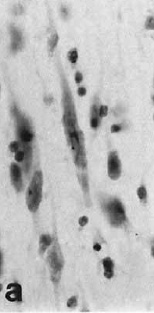Humpback Whales Have "Human-like" Brain Cells
 from CNN
from CNN Humpback whales have a type of brain cell seen only in humans, the great apes, and other cetaceans such as dolphins. This might mean such whales are more intelligent than they have been given credit for, and suggests the basis for complex brains either evolved more than once, or has gone unused by most species of animals. The finding may help explain some of the behaviors seen in whales, such as intricate communication skills, the formation of alliances, cooperation, cultural transmission and tool usage.
The Department of Neuroscience at Mount Sinai School of Medicine in New York studied the brains of humpback whales and discovered a type of cell called a spindle neuron in the cortex, in areas comparable to where they are seen in humans and great apes. Although the function of spindle neurons is not well understood, they may be involved in  cognition -- learning, remembering and recognizing the world around oneself. Spindle cells may be affected by Alzheimer's disease and other debilitating brain disorders such as autism and schizophrenia. The researches found spindle neurons in the same location in toothed whales with the largest brains, which the researchers said suggests that they may be related to brain size. Toothed whales such as orcas are generally considered more intelligent than baleen whales such as humpbacks and blue whales, which filter water for their food.
cognition -- learning, remembering and recognizing the world around oneself. Spindle cells may be affected by Alzheimer's disease and other debilitating brain disorders such as autism and schizophrenia. The researches found spindle neurons in the same location in toothed whales with the largest brains, which the researchers said suggests that they may be related to brain size. Toothed whales such as orcas are generally considered more intelligent than baleen whales such as humpbacks and blue whales, which filter water for their food.
 cognition -- learning, remembering and recognizing the world around oneself. Spindle cells may be affected by Alzheimer's disease and other debilitating brain disorders such as autism and schizophrenia. The researches found spindle neurons in the same location in toothed whales with the largest brains, which the researchers said suggests that they may be related to brain size. Toothed whales such as orcas are generally considered more intelligent than baleen whales such as humpbacks and blue whales, which filter water for their food.
cognition -- learning, remembering and recognizing the world around oneself. Spindle cells may be affected by Alzheimer's disease and other debilitating brain disorders such as autism and schizophrenia. The researches found spindle neurons in the same location in toothed whales with the largest brains, which the researchers said suggests that they may be related to brain size. Toothed whales such as orcas are generally considered more intelligent than baleen whales such as humpbacks and blue whales, which filter water for their food.The humpbacks also had structures that resembled "islands" in the cerebral cortex, also seen in some other mammals. These islands may have evolved in order to promote fast and efficient communication between neurons. Spindle neurons probably first appeared in the common ancestor of hominids, humans and great apes about 15 million years ago, and they are not seen in lesser apes or monkeys.


No comments:
Post a Comment